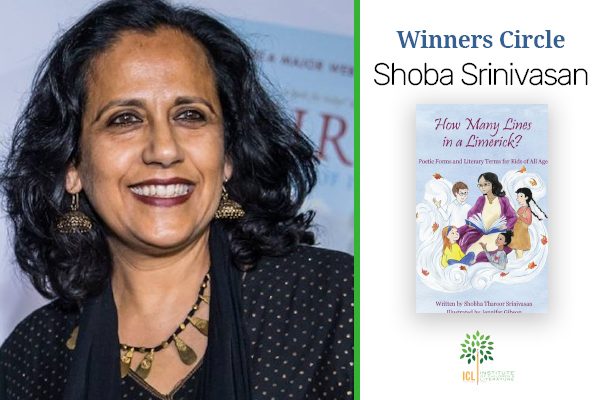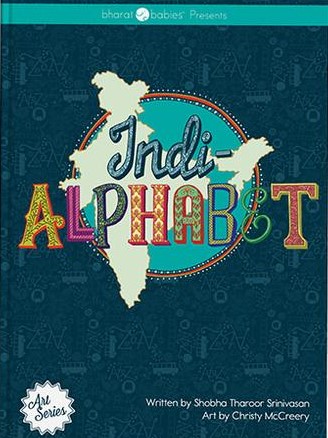1000 N. West Street #1200, Wilmington, DE 19801
© 2024 Direct Learning Systems, Inc. All rights reserved.
Published Graduates

Shobha Srinivasan
Published Work: How Many Lines in a Limerick? Poetic Forms and Literary Terms for Kids of All Ages
Welcome to the Winners’ Circle where we celebrate the success of our ICL students. Today we are celebrating published author Shobha Tharoor Srinivasan!
What are the names of your books? Who are the publishers?
My most recent book is How Many Lines in a Limerick? Poetic Forms and Literary Terms for Kids of All Ages (a poetry reader/picture book) and is published by Clearfork Publishing.
Indi-Alphabet is published by Mango and Marigold Press (formerly Bharat Babies)
Give us a short summary of your books.
How Many Lines in a Limerick? introduces readers to poetic forms like sonnets, nonets and limericks, poetic stanzas of various lengths, and metered lines that demonstrate the beat and rhythm of rhymed and unrhymed poetry. The creative examples and word play draw readers of all ages to the vast variety of poetry and invite children to use their inventive artistry to write as well.
Indi-Alphabet is an oversized picture book that is part of an Art Series that takes readers on a journey through the subcontinent of India. It is written in rhyming quatrains, has maps and fun facts on each page and is vibrantly illustrated. “We’ll sample yummy biryani, search for wild orange tigers in animal reserves, learn about bejeweled Maharajas, and encounter the mighty Mughals. With whimsical verses and vibrant images, Indi-Alphabet brings to life an India both familiar and unfamiliar.”
Tell us a bit about your path to publishing, from idea to submission to published.
As a mother and now a grandmother I am always reading children’s literature. Many years back I volunteered in a weekend enrichment program for elementary school children where I designed and taught a class called “Fun with Poetry.” I was surprised how daunted some young people were by the idea of poetry, and by what they saw as an inflexible form with rules for rhyme schemes and meter. But by the end of the day, they had all written poems and had such fun with their own compositions. The idea of a “poetry reader” that unpacks poetry in an accessible way had been percolating in my mind since that day. It was the impetus for writing How Many Lines in a Limerick?

When I’ve written a manuscript I’m happy with, I scour the internet for publishers whose book list and philosophy I like, check out the presses of similar themed books, read newsletters, and connect with online writing groups to decide where to send my pitch. With both recently published books I was pleased and fortunate that my manuscripts resonated immediately with the Publishers’ creative teams.
How long have you been writing?
The first story I ever published was about bunny rabbits and their mischievous escapades. The children’s section of the weekend Hindu newspaper in India where I lived, carried the story, and it was thrilling to see my name in print, with illustrations of rambunctious rabbits along with my short story on the page. I must have been in middle school at the time. Then I wrote a mawkish “MIDDLE”—a short oped—for the Times of India. I was 16 or 17 and questioning the inequalities around me. I used to write poems for fun when I was a child. I found the short form easy to express my adolescent emotions.
What’s your favorite genre to write and why?
I like writing both prose and poetry. But have found that most of my published picture books have been written in rhyme. I enjoy the challenge of writing within a particular structure and meter to unravel the threads of the story. As a professional Voice Over talent, I appreciate the sound of words and the music of reading aloud.
Please list the course or courses you’ve taken with ICL.
I have only taken one course with ICL. It was a one-on-one correspondence course that was an “Introduction to Children’s Literature” course.
How has taking our course helped your writing and/or career?
I worked with an instructor who set weekly tasks and provided feedback and critiques of my writing. The regular deadlines and creative assignments provided an impetus to keep writing. This, of course, was many years ago. The first children’s book that I wrote was inspired by the development field. As a grant-writer who used words to draw funders to projects, I recognized the value of a good story to build interest and effect change. My first book, A Pie Surprise and Other Stories (Mango Books), told stories from around the world in which young protagonists expressed selflessness and generosity of spirit. The publisher called them the “giving stories.”
Have any of your class assignments been published?
The kernel of two of the stories in Pie Surprise and Other Stories sprung from writing assignments I did years back with my ICL instructor.
Do you have a favorite writing tip you’d like to share?
In my career as a Development professional and grant writer, rejections were par for the course and I learned early on to pick myself up, polish the grant application and submit to other funders. I believed in the project I wrote about and in the services we provided so the writing and the rewriting was sincere and effective. It is important that writers remain committed to their craft and their work. It is important not to be discouraged by the many polite rejections from Publishers that come your way as you navigate the path to publishing your manuscript.
If you could travel back in time and give yourself one piece of writing advice, how far back would you go, and what would you tell yourself?
I suppose I would tell myself off for having waited until my children left home to pursue my own writing career. I’ve learned over the years that you can always play multiple roles quite successfully in life.
Please tell us the best or most valuable thing you learned from your experience with ICL.
I confess that my classes with ICL were many decades back. But I remember the joy and welcome distraction of the creative, writing assignments when my other pleasures at the time were in the home and with the particular demands of two young children.
Your career has spanned multiple worlds. What is it like to be a storyteller in different mediums and platforms?
There are parallels in each field. With the children’s audio books that I narrate as a Voice Over talent I use the modulation, inflection and expression of my voice to draw children to the stories I read aloud. As a writer, I use compelling and creative words to engage readers. Print modelling, which I’ve done for a number of advertising campaigns, is also a way of using yourself to tell the story of a product. Grant writing uses the power of words to draw funders to programs and projects that they wish to support. It is important, however, to separate performative work from honest exposition. In all the mediums that I’ve mentioned, sincerity in the telling of the story is crucial for it to be received well by readers.
Shobha Tharoor Srinivasan is a California-based children’s author, professional voice talent, poet, and translator who came to this second career from the world of non-profit, where she spent two decades using her words to bring funds to disability initiatives. Her voice can be heard in documentaries, educational and journalistic initiatives, and audio books, both in India and the United States, and her essays and stories have appeared in publications including India Currents, Skipping Stones, and Scroll.in. She has published five children’s books in India with DC/Mango Books and Tulika, and her work was anthologized in A Hug for the World (Clear Fork Publishing). All proceeds from that volume were for victims of Hurricane Harvey. Indi-Alphabet was published in 2018 by Mango & Marigold Press (formerly Bharat Babies) and was recognized with a Purple Dragonfly Award for Diverse Literature. How Many Lines in a Limerick? (Clear Fork) was published on September 15, 2020. A children’s book on the artist Raja Ravi Varma is forthcoming from Westland Publishing. You can learn more about her at www.shobhatharoorsrinivasan.com.
1000 N. West Street #1200, Wilmington, DE 19801
© 2024 Direct Learning Systems, Inc. All rights reserved.
1000 N. West Street #1200, Wilmington, DE 19801
© 2024 Direct Learning Systems, Inc. All rights reserved.
1000 N. West Street #1200, Wilmington, DE 19801
© 2024 Direct Learning Systems, Inc. All rights reserved.